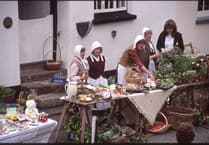TAVISTOCK, extensively re-modelled in the 19th century by the 7th Duke of Bedford, using the enormous profits made from his interests in Devon Great Consols copper mine, is testimony to one of the greatest periods of economic, technological and social development Britain has ever known.
Pupils from St Peter's School, Bere Alston Primary School and students from Tavistock College have been exploring their extraordinary heritage with mining experts, artists, map-makers, musicians, theatre-makers and metal-smiths.
Two months of creative exploration will culminate in different events in the schools at the end of March and also the unveiling of a colourful graphic map made by the children of Bere Alston School on March 27 at 10.15am in the passenger walkway at Plymouth Railway Station.
Everyone is welcome to go along and support them. They have used red iron oxide and copper oxide from the Tamar Valley Mining sites to create patterns for the map, that will show the routes across the ocean that took Cornish mining to far flung corners of the earth.
The entertaining map will be on permanent display at the station and will bring to life the way in which Cornish miners, nicknamed 'Cousin Jacks', went global with their world class technology and skill with Plymouth becoming a gateway for emigration to South Africa, South America, North America and Australia.
Local school children are writing poetry, inspired by the Tamar Valley mining landscape and these will be engraved onto slate tiles for permanent display at the Tamar Trails Centre.



